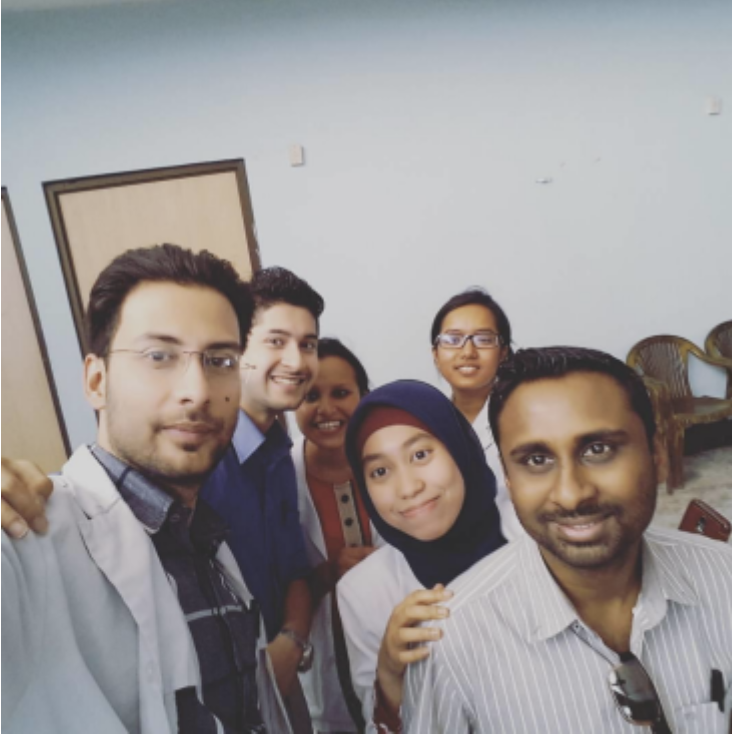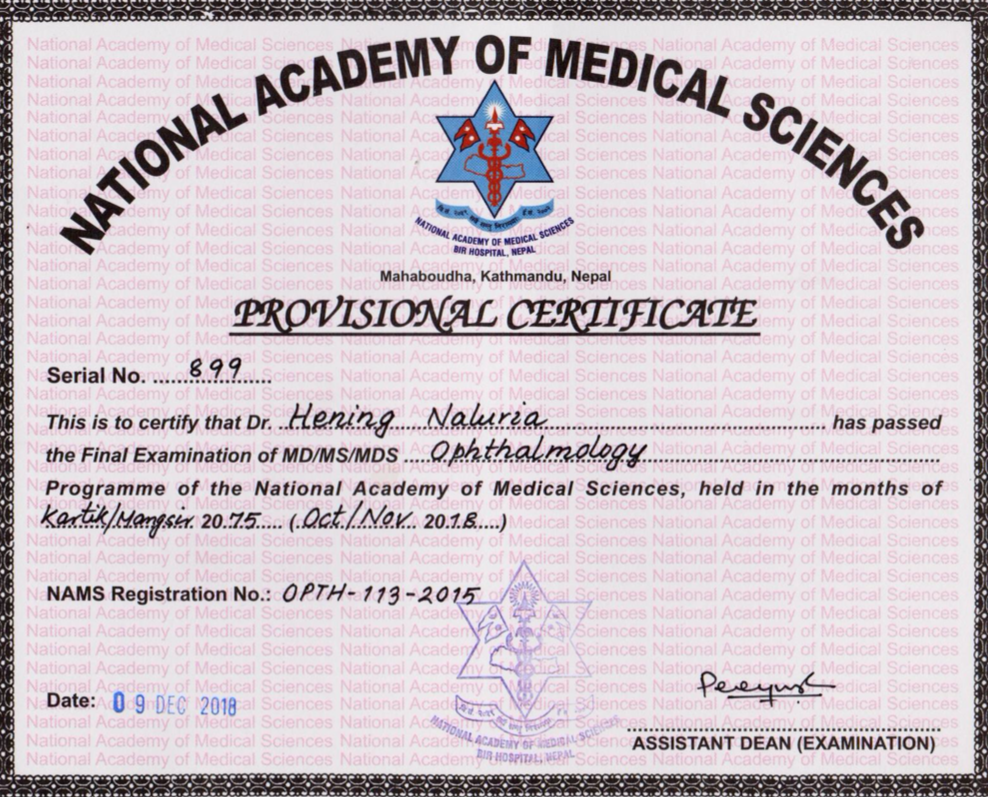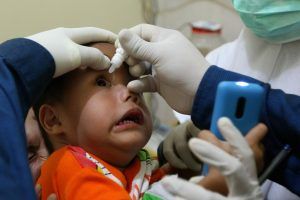- EXPERIENCES DURING RESIDENCY PROGRAM
- Introduction
My journey to become an eye specialist began when I participated in the surgical outreach at Jombang, East Java, Indonesia in April 2015, the surgical outreach was held for 3 days and my job was to examine visual acuity.
On the day of the interview for student admission (September 2015), accompanied with two gentlemen, I went to National Academy of Medical Sciences (NAMS). I thought the two gentlemen are NAMS employees. In the interview room, I found out the two gentlemen were my interviewers, during my study, it turned out that they are Saiju Sir and Govinda Sir, who is the Director of Hospital Service and the Academic Director of Tilganga Institute of Ophthalmology respectively. They only gave one suggestion that I must be fluently in speaking Nepali, I was immediately stressed.
The day after the interview day, I was invited to participate in surgical outreach at the Pullahary Monastery. There I met for the first time with Dr. Sanduk Ruit, where I met him in the operating room. While operating he told me “Hening, don’t be afraid, you are safe during your study in Nepal, welcome to Tilganga”. In that surgical outreach I learned to see the course of surgical outreach as a whole and I was asked to help in block room, where the block room is a place to give anesthesia in the eye.
My activities in Tilganga began with meeting Reeta Ma’am. She greeted me in her room and asked if you could speak Nepali. With confidence I answered “mathi hernus and tala hernus”. She asked again “do you know what that means”. I just answered “mathi hernus is look down and tala hernus is look up”. She just laughed and said “good”. After a few days I just realized that what I said was reversed, which is “mathi hernus is look up and tala hernus is look down”. One month later I found out she was a CEO at Tilganga Institute of Ophthalmology.
On November 2015, I began to join the residency program, I just got to know 3 words of Nepali Language, “Namaste, Tala (down), mathi (up)”, every time I said that, the all other person laughed. Then from 3 words increased to 9 words ” kukhura ko masu (chicken-food), khau (eat), basnus (sit), vok lagyo (hungry), daya (right), baya (left), kaan ma hernus (look at my ear), aankha kholnus (open your eye), aankha banda garus (close your eye)”. Speaking English can be great, but if we can’t speak Nepali it can be stressful, because what we face every day are patients who speak Nepali. I remember an Indonesian proverb about “Wherever ground is stood on, the sky is held high” (Wherever we live, we must observe the local custom). I ended up to have a Nepali to English dictionary, but after opening it, I more get a confusion then I cancelled to buy. So, I decided to learn by listening my friend how they speak to the patient. After 6 months finally I can speak to patients using Nepali, and until now I can speak Nepali
fluently to the patients. I believe a person’s success is measured by the ability to communicate. The ability to communicate and accept all parties is an asset for the progress of study, so that everything goes well.
I was also fascinated by all the consultants and employees who often used the stairs even though there was a lift. Once when I came out of the canteen, I was waiting for the lift to go downstairs. I met Saiju sir and he said “don’t use lift, we have to exercise”. I only answered yes sir, I still use the lift. Then on the same day, I was stuck in the lift for quite a long time. And I pray “God forgive me because I did not hear the Saiju Sir’s words”. Regarding time, Saiju sir became my mentor.
- Experience as first year resident
During my study, I got room facilities at the Tilganga hostel, which is provided for residents who came from out of town and foreign residents. There are ten rooms in total, eight rooms for residents who want to stay, and two rooms for residents who have emergency duties. At that time, only three residents always stayed at the hostel, namely one resident from second year (Dr. Suresh Rasaily) and two residents from third year (Dr. Hom Bahadur Gurung and Dr. Samyek Shakya), they all came from Nepal. The total of first year residents are 6 residents, including one resident from Indonesia (me), one resident from Maldive (Dr. Mohammed Azzam), four residents from Nepal (Dr. Isha Shrestha, Dr. Ramita Kharel, Dr. Kaushal Pokhrel, and Dr. Rabindra Singh Thakuri).
a) Our activities in Outpatient Department (OPD) and Operating Theater (OT)
Our activities as first year residents are to go to Outpatient Department from Sunday till Friday at 8 am until the completion of the patient and follow the schedule made by seniors. During the first two months, each first year resident attended a second senior year for orientation, that’s when we learn how doing eye examine, managing a therapy and how to educate patients. Because I also need to learn Nepalese, so in the first two months I did it by listening to my seniors how they speak Nepali.
In the third month, first year resident has been given a slit lamp, so we can examine the patient and we are obliged to consult a senior before sending the patient home, it continues until the first 6 months. Six months later we are trusted to discharge the patient if we are sure, if we feel difficulties we can consult and discuss with second year seniors. There is a rule if we want to consult with seniors, we cannot consult directly to consultants. We have to be a tiered consult, first we have a consult to second year seniors, if second year seniors have insufficient idea about the patient, both of them will go together to consult with third year resident. If third year resident doubt on his or her decision concerning the patient, then we will consult to a fellow, and finally to a consultant. This regulation was enforced so that all residents can learn together to resolve the case.
First and second year residents taking turns to the Operating Theater and our job is to be an assistant, observe and learn the steps of the surgery, write the therapy that will be given to the patient.

b) Presentations and Classes for Residents
We also provide topics for presentations, which are held every Monday and Wednesday. All consultants and residents must attend. It was during the presentation that our mentality and self-confidence were tested. Consultants do not hesitate to ask the presenters and other residents. We should focus on the topic being presented and focus on opening our ears, oftenly a consultant calls our name on the sidelines of the presentation. There is another class for all residents, namely a class with a teacher named DB Karki Sir, he is a senior ophthalmologist in Nepal. His classes are every Tuesday and Thursday.
c) Minor Surgeries
We are tutored by second year residents to learn about minor surgeries such as pterygium, chalazion, evisceration, eyelid and conjunctival repair then at the end of the first year as residents we should be able to do it independently.
d) Emergency Duty
We also have started emergency duty, we are supervised by one second year or third year resident and one consultant. Senior is obliged to be in the hostel, so if we run into difficulties we can consult to our senior and senior will come to the Outpatient Department to help us solve cases that we think are difficult. e) Surgical Outreach
In September 2016, I had the opportunity to participate in surgical outreach held in Magelang and Purwokerto, Central Java, Indonesia. I came with the Nepali team and my job was in the screening section, where I increased my skills and courage to make a decision whether this patient needs surgery or not. I also had the opportunity to do pterygium surgery, so after joining from that surgical outreach my surgical skill for pterygium surgery was very good.

f) Periphery Posting
Our last year as a first year resident we will be sent to a periphery to learn about Small Incision Cataract Surgery (SICS), I was sent to Geta Eye Hospital in November 2016, I was well received in the hospital, and provided a room to stay, my room was on the second floor of hospital, my mentor for studying SICS is Dr. Suresh Raj Pant, he is the Director of Geta Eye Hospital. I was 1.5 months there and managed to do SICS in 62 cases. There was an impressive experience. My patient (while doing SICS), in the middle of the surgery process, the patient innocently said “Doctor, I want to go to the toilet to urinate”. I was immediately confused, and my mentor (Dr. Suresh) came and asked why I looked confused. I said the patient wanted to go to the toilet. I think he want to take over the surgery, but he just said “Good, then finish it quickly”. After that, every time before doing the surgery, I just pray that the patient will use diaper.

3. Experience as second year resident
Our activities in second year of residency program were not much different from those of the first year. The different is our responsibility, now we have to share our knowledge to first year residents who have just entered and handle general Outpatient Department. An Outpatient Department room contains one person from second year resident who works together with one or two persons of first year residents.
In the second year, residents have to present cases and journals. For emergency duty, we have to be ready if juniors need us for consultation and come to Outpatient Department when juniors need the advices.
4. Experience as third year resident
In third year of the program, we did not examine patients in general Outpatient Department. There are 8 subspecialties at Tilganga Institute of Ophthalmology namely Pediatric Ophthalmology, Uvea, Neuro Ophthalmology, Retina, Cornea, Oculoplasty, Glaucoma, and Refractive Surgery Unit. We will go around the subspecialty clinic every 1.5 months. Our activities at the subspecialty clinic is to examine new patients and who have been referred from general OPDs, while in the operating room we follow consultants according to the subspecialty where we are posting. We also have to make presentations on cases and journals, and always ready for emergency duties.
- Surgical Outreach
In the third year, every resident took turns being invited to participate in surgical outreach, at that time I had the opportunity to take part in surgical outreach at Rolpa and Pullahari Monastery. My first surgical outreach was in Rolpa and the second was in Pullahari Monastery. It took two days and one night by bus to reach Rolpa. It was the first time I did a cataract surgery at Rolpa. At night the whole team rested at the inn and will continue the journey again the next morning. I did surgeries in the morning and screening in the afternoon. I did alternate surgery with general ophthalmology (Dr. Hom Bahadur Gurung), and I had the opportunity to operate from morning until lunch time. I saw a lot of patients who came excitedly for surgery. There was an incident that impressed me, there was a grandfather who was accompanied by his wife, the grandfather came using a stick, and after the surgery the grandfather came home without using a stick.
Surgical Outreach in Rolpa (2018)
I was very impressed when I joined the eye camp at Rolpa with Dr. Sanjita Sharma and Dr. Hom Bahadur Gurung. During the trip I said to Hom dai ” I want to go to the toilet”. After the bus stops, he said “Hening, go to the toilet now and come back soon”. Then I asked him “where is the toilet?”. Hom dai answered “Didn’t you see the largest toilet in the world?”. I’m astonished, OMG!!!, hopefully there are no snakes.
I also had the opportunity to participate in the surgical outreach held at the Pullahari Monastery, only about two hours from Kathmandu. I joined at that surgical outreach with Dr. Sanduk Ruit, Dr. Srijana Adhikari, and Dr. Sanjita Sharma. I have the task to teach junior the steps of Small Incision Cataract Surgery (SICS), manage the complication as much as I can. In the that surgical outreach, I also taught the steps of SICS to an ophthalmologist from Tajikistan. We are also joined surgical outreach at the Tilganga Institute of Ophthalmology.
- a) TRAININGS, COURSES AND SYMPOSIUMS
June 2018 Speaker
XIVth Biennal SAARC Academy of Ophthalmology Conference 2018 In Conjunction with XXth Nepal Ophthalmic Society Annual Meeting. Choroidal Osteoma Masquerading as Posterior Uveitis (Poster).
SAARC Academy of Ophthalmology.
May 2018 Participant.
Medical Education Training.
National Academy of Medical Science, Bir Hospital, Kathmandu, Nepal.
Jan 2018 Participant.
Symposium on Minimally Invasive Glaucoma Surgery (MIGS).
Tilganga Institute of Ophthalmology, Kathmandu, Nepal.
Sept 2017 Speaker
PIT 42 PERDAMI. 42nd Annual Sciantific Meeting.
Outcome Surgery in Children with Unilateral Congenital and Developmental Cataract.
PIT PERDAMI.
May 2017 Participant.
Corneal Symposium 2017.
Tilganga Institute of Ophthalmology, Kathmandu, Nepal.
Dec 2016 Participant.
Early Detection and Referral of Retinoblastoma – A reason to save sight and life.
Tilganga Institute of Ophthalmology, Kathmandu, Nepal.
June 2016 Participant.
Advanced Cardiac Life Support Training.
National Academy of Medical Science, Bir Hospital, Kathmandu, Nepal.
April 2016 Participant.
Research Methodology Training.
National Academy of Medical Science, Bir Hospital, Kathmandu, Nepal
Dec 2015 Participant.
Retina Symposium 2015.
Tilganga Institute Of Ophthalmology, Kathmandu, Nepal
Dec 2015 Participant.
Emerging Interventions in Oculoplasty. Cadaveric Dissection Course for Endoscopic Dacryocystorhinostomy. Tilganga Institute Of Ophthalmology, Kathmandu, Nepal.
- b) SCIENTIFIC WORK/PAPERS
April 2016 – December 2017 Surgical Outcome of Eyelid Carcinoma, Thesis.
- c) CLINICAL EXPERIENCES
May 2018 Tilganga Institute of Ophthalmology.
– SICS : 5 cases
Eye Camp
April 2018 Pullahary Outreach Microsurgical Eye Clinic.
– SICS : 27 cases
– SICS together with MD Ophthalmology from Tajikistan : 23 Cases
Eye Camp
January 2018 Rolpa Outreach Microsurgical Eye Clinic (600 km from Kathmandu). – SICS : 15 cases
Eye Camp
June 2017 Tilganga Institute of Ophthalmology.
– SICS : 5 cases
Eye Camp
April 2017 Tilganga Institute of Ophthalmology.
– SICS : 5 cases
Eye Camp
Nov 2016 – Dec 2016 Geta Eye Hospital. Dhangadi, Nepal (Border of India). – Small Incision Cataract Sugery (SICS) : 62 cases
Eye Camp
September 2016 Magelang and Purwokerto Surgical Outreach
– Pterygium Surgery : 181 cases
- d) CLINICAL EDUCATION
Retinoscopy : 70 cases
Procedures (Investigation)
– Visual Field : 9 cases
– Indirect Ophthalmoscopy with fundus drawing : 10 cases
– Ultrasonography : 12 cases
– Biometry : 12 cases
– Hess Charting : 10 cases
– Diplopia Charting : 10 cases
– Corneal Scraping : 10 cases
– Fundus Fluorescein Angiography : 10 cases
- e) SURGICAL EXPERIENCES
| Surgery Observations Performed Surgery as First
Performed Surgery Under Performed Surgery Assistant Supervisor Independently |
||||
| Entropion | 2 | 8 | ||
| Ectropion | 2 | 8 | ||
| Chalazion | 30 | |||
| Pterygium | 201 | |||
| Strabismus | 10 | |||
| Dacryocystorhinostomy (DCR) | 5 | 5 | ||
| Dacryocystectomy (DCT) | 1 | 5 | ||
| Cataract Surgery (SICS) | 3 | 142 | ||
| Peripheral Iridotomy | 4 | 5 | ||
| Trabeculectomy | 10 | |||
| Evisceration | 1 | 9 | ||
| Enucleation | 6 | 4 | ||
| Retinal Detachment Surgery (Scleral Buckling) | 10 | |||
| Vitrectomy | 10 | |||
| Ptosis Surgery | 5 | 5 | ||
| Penetrating Keratoplasty | 7 | 3 | ||
| Intravitreal Injection | 3 | 5 | ||
| Repair
1. Lid Lacerations 2. Corneal 3. Scleral Conjunctival laceration |
2
3 |
2 | 6
3 3 |
Written by, Hening Naluria
Original PDF article can be viewed here: 1. Dr Hening Naluria – Experiences during residency program-converted



Leave a Reply